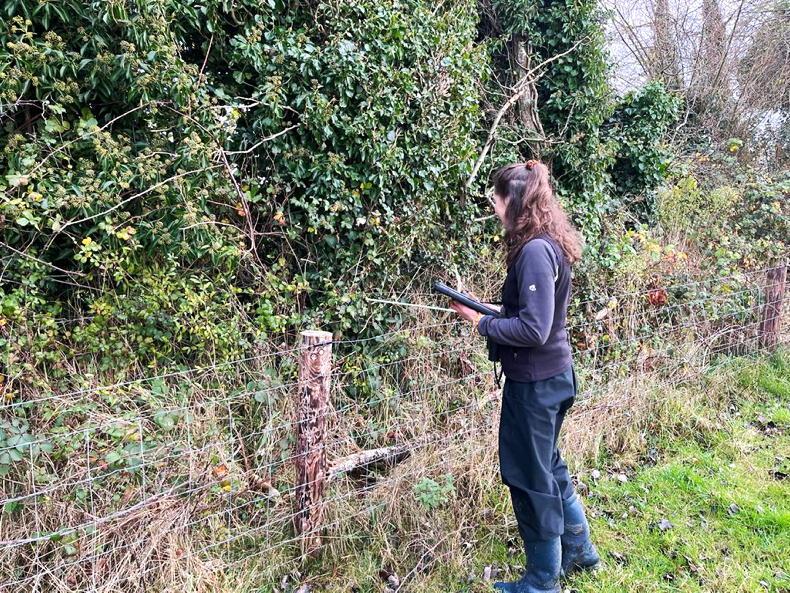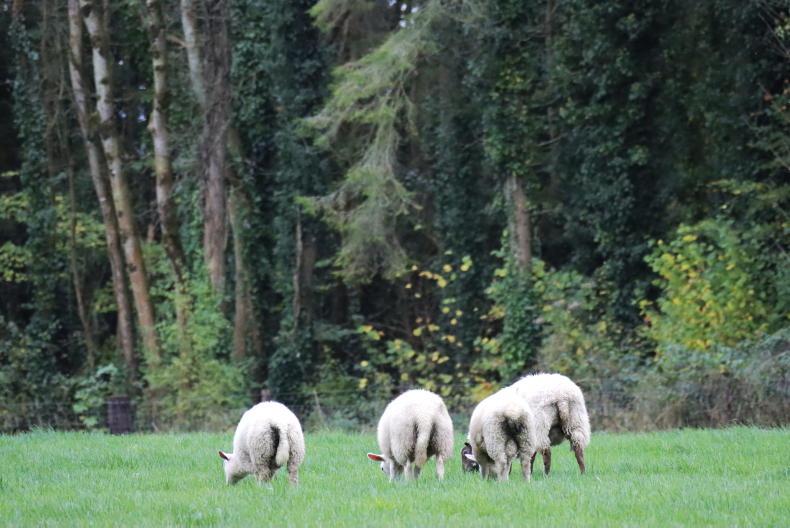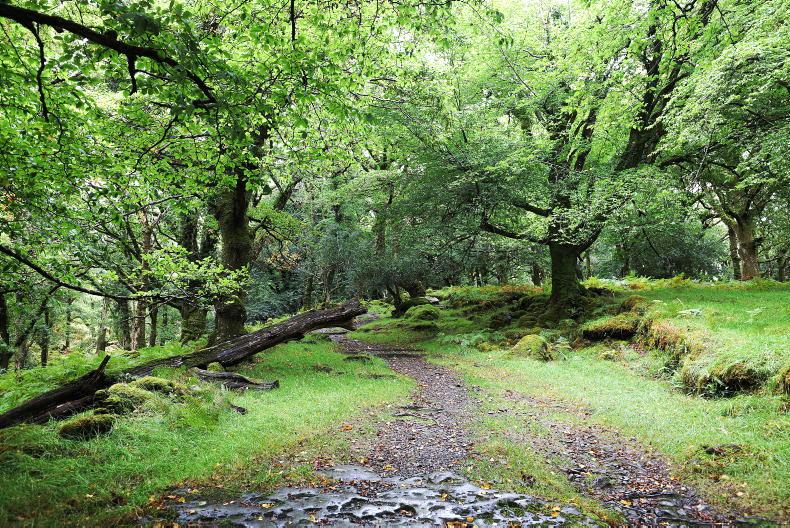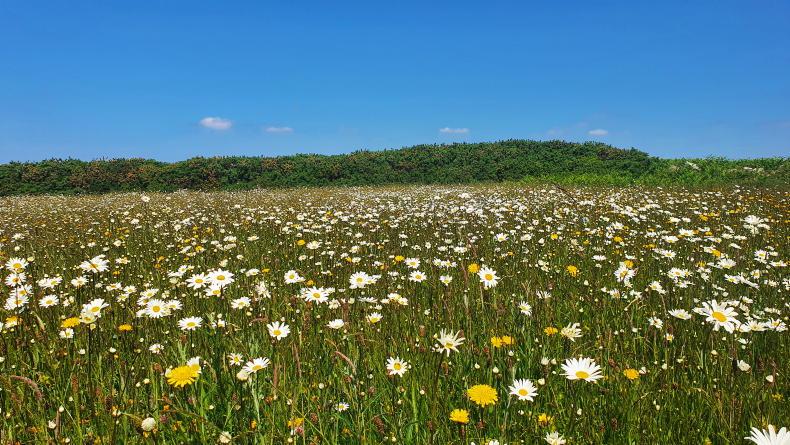Biodiversity scoring was carried out on Tullamore Farm on 7 December. The final report has now been compiled and a Farm Biodiversity Index (FBI) score of 5C was given to the farm.
The FBI is a combination of the Space for Nature (SFN) on the farm, and the quality of the SFN. The ‘5’ in the FBI signifies that there is 5% of the farm classified as SFN, with the average quality of the SFN on the farm being a ‘C’. The quality ranges from an ‘A’ being the highest quality to an ‘E’ being the lowest quality score.
As a Farming with Nature Standard, 10B is the target, so that would be 10% SFN with an average quality of a ‘B’ score.
Therefore, there needs to be some changes made on Tullamore Farm to increase the score. Below, the different habitats present and the ways in which improvements can be made to these areas are described.
Bee scrape
There are a number of bee scrapes across the farm which appear to be active. Bee scrapes can be observed through checking for small holes in bare soil on a bank, which are the tunnels of solitary bees.

Bee scrape on Tullamore Farm.
These bees do not form a hive but instead burrow into the soil to form a tunnel into which they lay an egg and leave behind some food in the form of pollen. Next year, these patches will be checked for activity at the start of the summer.
Field margins
Field margins scored well on Tullamore Farm. Increasing the widths of the margins is one way the SFN can be increased. This would lend many benefits to species such as small mammals, which in turn would benefit the barn owl. Increasing the field margins would also benefit pollinators such as bees, flies, butterflies and moths, which then benefit birds and bats which feed on them. For better-quality field margins, farmers should avoid nutrient input in these areas.
Extensive grassland
According to this particular assessment method, there is one small area of extensive grassland on the farm. There is good potential for it to be managed for biodiversity, with the possibility of altering the grazing pattern to allow flowers to bloom and set seed. The area would benefit from reduced nutrient input from a wildlife point of view, as this would encourage more floral species to grow and support various insects including butterflies.
Hedgerows
Many hedgerows on the farm were recently topped, and not topping these hedgerows will increase the quality score for the habitats and help increase the overall FBI score. In addition to this, letting the hedgerows grow up can help increase the carbon sequestration value of the farm compared to annually topped hedgerows.

Ivy hedgerow Tullamore Farm
The mature hedgerows in other areas of the farm scored well. They are flowering every year and providing fruit for insects, birds and mammals. They also support the growth of ivy (pictured), a later flowering plant, which benefits pollinators in late September. Hedgerows are an important foraging habitat for bats, as well as acting as wildlife corridors.
Riparian buffers
The average width of the riparian buffers on Tullamore Farm is 3m and wider. These buffer zones act as an area to provide habitats and shelter for the wildlife such as birds and mammals along the riverbank. Riparian buffers are also important for intercepting nutrients from surface runoff, which helps improve water quality.
Protecting the water quality in the stream running through the farm has many positive effects downstream, including better-quality habitats for aquatic vertebrates, fish, birds and mammals such as otters. It also has positive effects on estuarine areas.
Woodland

There is a nice mix of woodland on the farm, comprising of a mix of native and non-native tree species, both of which provide benefits for wildlife.
Biodiversity scoring was carried out on Tullamore Farm on 7 December. The final report has now been compiled and a Farm Biodiversity Index (FBI) score of 5C was given to the farm.
The FBI is a combination of the Space for Nature (SFN) on the farm, and the quality of the SFN. The ‘5’ in the FBI signifies that there is 5% of the farm classified as SFN, with the average quality of the SFN on the farm being a ‘C’. The quality ranges from an ‘A’ being the highest quality to an ‘E’ being the lowest quality score.
As a Farming with Nature Standard, 10B is the target, so that would be 10% SFN with an average quality of a ‘B’ score.
Therefore, there needs to be some changes made on Tullamore Farm to increase the score. Below, the different habitats present and the ways in which improvements can be made to these areas are described.
Bee scrape
There are a number of bee scrapes across the farm which appear to be active. Bee scrapes can be observed through checking for small holes in bare soil on a bank, which are the tunnels of solitary bees.

Bee scrape on Tullamore Farm.
These bees do not form a hive but instead burrow into the soil to form a tunnel into which they lay an egg and leave behind some food in the form of pollen. Next year, these patches will be checked for activity at the start of the summer.
Field margins
Field margins scored well on Tullamore Farm. Increasing the widths of the margins is one way the SFN can be increased. This would lend many benefits to species such as small mammals, which in turn would benefit the barn owl. Increasing the field margins would also benefit pollinators such as bees, flies, butterflies and moths, which then benefit birds and bats which feed on them. For better-quality field margins, farmers should avoid nutrient input in these areas.
Extensive grassland
According to this particular assessment method, there is one small area of extensive grassland on the farm. There is good potential for it to be managed for biodiversity, with the possibility of altering the grazing pattern to allow flowers to bloom and set seed. The area would benefit from reduced nutrient input from a wildlife point of view, as this would encourage more floral species to grow and support various insects including butterflies.
Hedgerows
Many hedgerows on the farm were recently topped, and not topping these hedgerows will increase the quality score for the habitats and help increase the overall FBI score. In addition to this, letting the hedgerows grow up can help increase the carbon sequestration value of the farm compared to annually topped hedgerows.

Ivy hedgerow Tullamore Farm
The mature hedgerows in other areas of the farm scored well. They are flowering every year and providing fruit for insects, birds and mammals. They also support the growth of ivy (pictured), a later flowering plant, which benefits pollinators in late September. Hedgerows are an important foraging habitat for bats, as well as acting as wildlife corridors.
Riparian buffers
The average width of the riparian buffers on Tullamore Farm is 3m and wider. These buffer zones act as an area to provide habitats and shelter for the wildlife such as birds and mammals along the riverbank. Riparian buffers are also important for intercepting nutrients from surface runoff, which helps improve water quality.
Protecting the water quality in the stream running through the farm has many positive effects downstream, including better-quality habitats for aquatic vertebrates, fish, birds and mammals such as otters. It also has positive effects on estuarine areas.
Woodland

There is a nice mix of woodland on the farm, comprising of a mix of native and non-native tree species, both of which provide benefits for wildlife.












SHARING OPTIONS